You can listen to Hoosier History Live! live on the air each Saturday, or listen online at the WICR website during the broadcast on any computer with speakers, anywhere, or on a smartphone. We invite you to visit our website!
July 9 show
Amusement park history in Indy
Diving horses, roller coasters, Ferris wheels, bumper cars, dunk tanks, fun houses, landscaped gardens, shoot-the-chutes and waterslides. All were on the summer menu - along with cotton candy and Coney dogs - for generations of Hoosiers who patronized three popular amusement parks in Indianapolis.
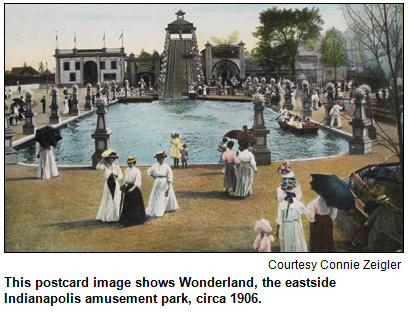 All three are bygone and had some dark chapters in their histories, including - in some cases - raging fires, racial discrimination, neighborhood objections over plans to serve alcohol and as many financial ups and downs as a wild ride.
All three are bygone and had some dark chapters in their histories, including - in some cases - raging fires, racial discrimination, neighborhood objections over plans to serve alcohol and as many financial ups and downs as a wild ride.
To explore the heritage of three major amusement parks that opened more than 100 years ago, Nelson will be joined in studio by historic preservationist Connie Zeigler, president and owner of C. Resources Inc.
A writer and historian, Connie has researched the beginnings - during the amusement park craze that swept the country in the early 1900s - of Riverside Amusement Park, the wildly popular attraction on the westside of Indy that flourished until the early 1970s. It's where generations of Hoosier children experienced the thrills of their first ride on a Ferris wheel and roller coaster.
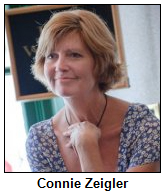 Connie, a regular columnist for Urban Times, the monthly newspaper serving historic neighborhoods in Indy, also has researched Wonderland Amusement Park, a lavish entertainment center on East Washington and Gray streets with a short (1906-1911) but spectacular and colorful life. When illuminated at night, Wonderland's 125-foot central tower was said to be visible for miles. Thousands of Hoosiers flocked to the amusement park, which featured an artificial lake, landscaped gardens and diving horses. (The latter included a mare named Queenie who became a crowd favorite.)
Connie, a regular columnist for Urban Times, the monthly newspaper serving historic neighborhoods in Indy, also has researched Wonderland Amusement Park, a lavish entertainment center on East Washington and Gray streets with a short (1906-1911) but spectacular and colorful life. When illuminated at night, Wonderland's 125-foot central tower was said to be visible for miles. Thousands of Hoosiers flocked to the amusement park, which featured an artificial lake, landscaped gardens and diving horses. (The latter included a mare named Queenie who became a crowd favorite.)
The third major amusement park in Indy was located in Broad Ripple and had a series of lives. Known as White City Amusement Park when it opened in 1906, the entertainment center was named after the "white city" architecture featured at the legendary 1893 World's Columbian Exposition in Chicago. White City burned to the ground in 1908 in a fire that started in its "Mystic Cave" attraction.
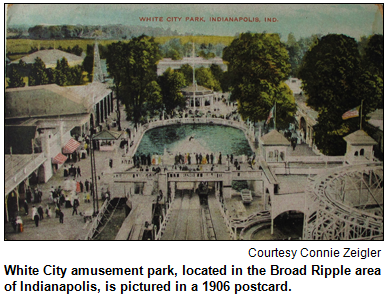 Wonderland also succumbed to flames (ironically, its attractions included a stunning reenactment of the 1889 Johnstown, Pa., flood), destroyed by a roaring nighttime blaze in 1911 that, as Connie put it in an Urban Times column, left the once-lavish amusement park "a soaked, smoldering ruin."
Wonderland also succumbed to flames (ironically, its attractions included a stunning reenactment of the 1889 Johnstown, Pa., flood), destroyed by a roaring nighttime blaze in 1911 that, as Connie put it in an Urban Times column, left the once-lavish amusement park "a soaked, smoldering ruin."
During its brief life, Wonderland not only drew thousands to its attractions such as a hydrogen-powered dirigible Connie says was "as big as two streetcars." The amusement park also drew protests from temperance advocates, including many residents of nearby Irvington, with plans for a German beer garden. (The garden eventually opened, sans beer.)
"In the early 1900s, amusement parks were considered 'edgy' places," according to Connie, who does a paid visual presentation about Riverside, Wonderland and White City. (The amusement parks also were the focus of her master's thesis.)
 "Amusement parks were located on the edges of town," says Connie, "and they tolerated behavior considered on the edges of what was socially proper then."
"Amusement parks were located on the edges of town," says Connie, "and they tolerated behavior considered on the edges of what was socially proper then."
After the devastating fire at White City, a new entertainment center, known as Broad Ripple Amusement Park or similar names, held forth at the site into the 1940s. Except for certain features - most notably, the country's largest outdoor swimming pool, which served as the site of the 1924 Olympic Trials won by Johnny Weissmuller - Broad Ripple Amusement Park did not match its White City predecessor in terms of inspiring awe.
Instead, Riverside was king of the heap in Central Indiana for decades. Beginning with just a toboggan run at its opening in 1903 on farmland near the White River, Riverside evolved into a sprawling amusement park that included a miniature railroad, a dance hall, a roller skating rink and a trove of rides. According to some estimates, more than 1 million visitors flocked to Riverside in 1952, one of its peak years. Currently there is a Facebook page for those who share their Riverside memories and photos.
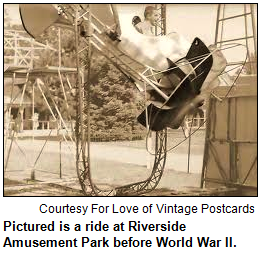 Riverside, however, was not beloved in every aspect. The amusement park outraged many Hoosiers by persisting with a "whites only" admission policy even into the 1960s, even as its surrounding neighborhood became increasingly diverse. African-Americans were permitted to visit only on "Colored Weekends," which were far from frequent.
Riverside, however, was not beloved in every aspect. The amusement park outraged many Hoosiers by persisting with a "whites only" admission policy even into the 1960s, even as its surrounding neighborhood became increasingly diverse. African-Americans were permitted to visit only on "Colored Weekends," which were far from frequent.
There also were controversies about possible histoplasmosis and the deterioration of the attractions. By some accounts, Riverside was losing more than $30,000 annually when it closed after the 1970 season.
So what developed on the sites of these once-popular amusement parks?
Riverside: Since 2000, subdivisions of homes, townhouses and condos, including River's Edge, have been built on the site.
Wonderland: The factory plant of P.R. Mallory and Co., an Indy-based electrical components manufacturer, employed hundreds of workers before it, too, closed.
White City: According to Connie, the lavish initial amusement park was located on what today is Broad Ripple's dog park, which opened as Indy's first "bark park" (where dogs can frolic off-leash) in 1999.
History Mystery question
For several decades before Riverside Amusement Park in Indianapolis closed in the early 1970s, its attractions included two major roller coasters. 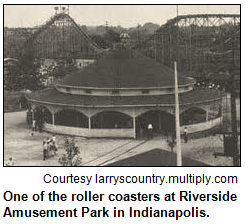 Showcased almost as dueling attractions, the two roller coasters sparked continual debates among patrons, particularly teenagers and children, about which was more terrifying to ride.
Showcased almost as dueling attractions, the two roller coasters sparked continual debates among patrons, particularly teenagers and children, about which was more terrifying to ride.
Question: Name one of the two large roller coasters at Riverside.
To win the prize, you must call in with the correct answer during the live show. The call-in number is (317) 788-3314, and please do not call until you hear Nelson pose the question on the air. Please do not call if you have won a prize from any WICR show during the last two months.
The prize is a one-night stay for two at the Canterbury Hotel in downtown Indianapolis, as well as a Yellow Rose Carriage Ride. These prizes are courtesy of the ICVA.
Roadtrip: Angel Mounds near Evansville
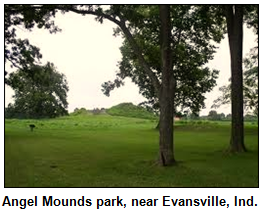 Chris Gahl of the ICVA tells us to head southwest from Indianapolis to Angel Mounds near Evansville. This state historic site was once a palisaded Middle Mississippian Indian village from about 1050 A.D. to 1450 A.D., when it was abandoned. It is estimated that about 1,000 Native Americans lived here, and the 450-acre site includes 11 man-made mounds, a town plaza and a village area.
Chris Gahl of the ICVA tells us to head southwest from Indianapolis to Angel Mounds near Evansville. This state historic site was once a palisaded Middle Mississippian Indian village from about 1050 A.D. to 1450 A.D., when it was abandoned. It is estimated that about 1,000 Native Americans lived here, and the 450-acre site includes 11 man-made mounds, a town plaza and a village area.
Angel Mounds was purchased by the Indiana Historical Society in 1938 with financial assistance from Eli Lilly II, and in 1947 the Indiana Historical Society transferred ownership to the state of Indiana.
Your Hoosier History Live! team,
Nelson Price, host and creative director
Molly Head, producer, (317) 927-9101
Chris Gahl, Roadtripper
Richard Sullivan, webmaster and tech director
Pam Fraizer, graphic designer
Garry Chilluffo, creative consultant
Michele Goodrich, Jed Duvall, grant consultants
www.hoosierhistorylive.org
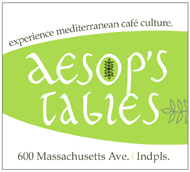






Please tell our sponsors that you appreciate their support: Aesop's Tables, Broad Ripple Brewpub, Heartland Truly Moving Pictures, Indiana Historical Society, Lucas Oil, Story Inn and The Society of Indiana Pioneers.
 Acknowledgments to Print Resources, Indianapolis Marion County Public Library, Monomedia, Indiana Humanities, Indianapolis Convention & Visitors Association, WICR-FM, Fraizer Designs, Heritage Photo and Research Services, Chelsea Niccum and many other individuals and organizations. We are an independently produced program and are self-supporting through organizational sponsorships, grants and through individual tax-deductible contributions through the Indiana Humanities Council. Visit our website to learn how you can support us financially.
Acknowledgments to Print Resources, Indianapolis Marion County Public Library, Monomedia, Indiana Humanities, Indianapolis Convention & Visitors Association, WICR-FM, Fraizer Designs, Heritage Photo and Research Services, Chelsea Niccum and many other individuals and organizations. We are an independently produced program and are self-supporting through organizational sponsorships, grants and through individual tax-deductible contributions through the Indiana Humanities Council. Visit our website to learn how you can support us financially.
July 16 show
Negro Leagues baseball and Indy
Step up to the plate for some historic baseball questions and insights. Did you know that in 1920, the very first game in the newly organized Negro Leagues was played in Indianapolis?
 Were you aware that one of the greatest stars of the Negro Leagues - a slugger often called "the black Babe Ruth" - was an Indy native?
Were you aware that one of the greatest stars of the Negro Leagues - a slugger often called "the black Babe Ruth" - was an Indy native?
During an era when major league baseball was segregated, the beloved Indianapolis Clowns and predecessor Indianapolis ABCs (which, as an independent team, was even competing in the 1910s) had a huge impact.
To explore the heritage of Negro Leagues baseball in the Hoosier state, Nelson will be joined in studio by Geri Strecker, a Ball State professor who is writing a biography of Indy native Oscar Charleston (1896-1954), an outfielder considered one of the greatest players - and, eventually, managers - in the Negro Leagues.
Nelson also will be joined by Indy native Cliff Robinson, who from ages 10 through about 14 was a batboy for the Indianapolis Clowns. Traveling with the team during the 1940s, Cliff visited nearly every major league ballpark in the country and has a mound of anecdotes.
Eventually leaving the road to attend Attucks High School and then college, Cliff became an educator, coach and administrator at several schools before ending his career as human resources director at IUPUI.
 Our show with Cliff and Geri (who also has put together a documentary with her Ball State students about black baseball in Indiana) will air just before the 14th annual Jerry Malloy Negro Leagues Conference meets in Indy, beginning July 21.
Our show with Cliff and Geri (who also has put together a documentary with her Ball State students about black baseball in Indiana) will air just before the 14th annual Jerry Malloy Negro Leagues Conference meets in Indy, beginning July 21.
During the conference, a historical marker will be placed on the site of the first organized Negro Leagues game, which involved the Indianapolis ABCs. The site was in the former West Washington Street Park, now part of the Indianapolis Zoo. (Oscar Charleston played center field during that game.)
The Indianapolis ABCs took their name from their sponsor, the American Brewing Company.
Another historic footnote: As many baseball enthusiasts know, future legend Henry Aaron made his debut with the Negro Leagues during the early 1950s with the Indianapolis Clowns.
© 2011 Hoosier History Live! All rights reserved.